
Pyropia nereocystis
Bull Kelp Laver, Purple Laver, Red Laver, Red Nori, Rose Nori
25 November 2022
Florencia Bay, Vancouver Island, B.C., Canada.
Tide (at time of in situ observations) mid-day high tide 12.8 feet (measured at Ucluelet Tidal Station). Evening low tides (the evening previous and the one to come) 0.3 feet. Tidal range experienced during our interactions was near the maximum (13 feet/4 meters) for this area.
Conditions: Overcast, light variable winds, high surf, humidity 84%, 9˚C.
Moon: Waxing Crescent (5.0%, 2 days); Previous Phase, New Moon, 23 Nov 2022 at 2:57pm PST; Next Phase, First Quarter, 30 Nov 2022 at 6:36am PST.
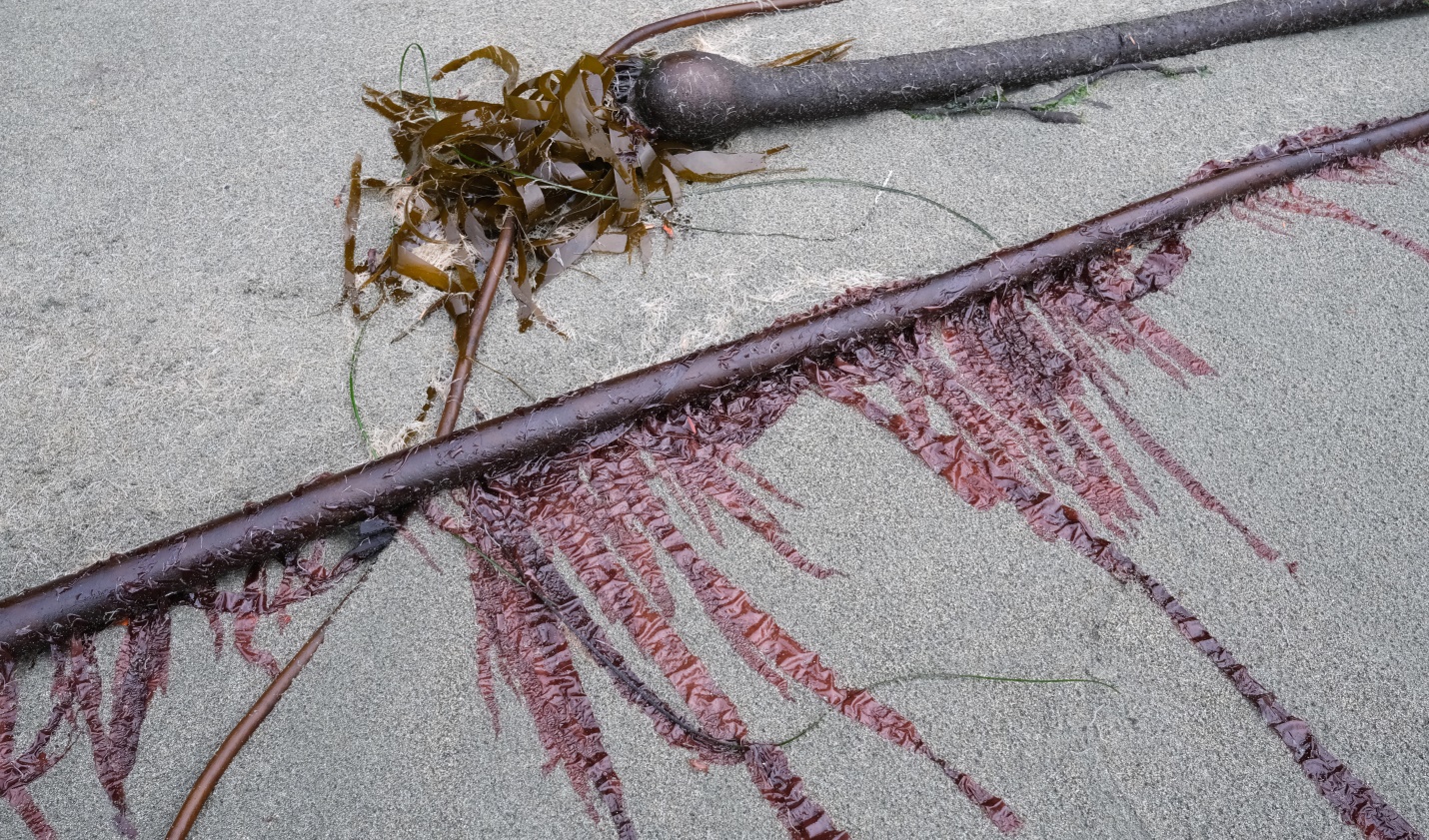
Figure 1: A mature Bull kelp has been newly washed ashore and along with it all the Pyropia nereocystis, Bull Kelp Nori, that was growing epiphytically thereon. Florencia Bay, Vancouver Island, B.C. Canada. November 25, 2022. Photo ID 27440 ©Seaweedwhisperings.com
Person 1:
At last we’ve found some lovely examples of Bull Kelp Nori, growing on a freshly tossed ashore Bull kelp.
There’s a freshness and vibrancy to its appearance.
Long crinkly ribbons splayed out on the sand.
Purplish-brown red in coloration.
Must enjoy its ride on the Bull kelp stem. When in water, ever moving in gentle swaying motion.
I think it’s “at one” with its Bull kelp host.
Looks like it can enjoy quite a range of water depths, as it is growing all the way from the holdfast to the kelp’s pneumatocyst.
Blades are very thin, but strong and stretchy.
Doesn’t seem to have much to share beyond its simple beauty.
Confident and relaxed.
Person 1, second interaction:
Crepe ribbons – look like decorations / decorative.
Color – a royal purple-red.
Very few Bull kelps on the beach had such a profusion of the Bull Kelp Laver; I wonder what attracts it to one kelp over another?
Thinking about this laver’s positional relationship to the Bull kelp stipe, I sensed that there is a mechanism that permits it to avoid clinging to the stipe. Probably when there is peak movement for the kelp, the laver rides closely alongside. Then maybe when the current shifts the turbulence created permits the laver to express themselves most differently in direction / position from that of the host. At times of little water movement, it seems the Pyropia could dangle and sway quite independently.
Strong and flexible.
Does it have independent CONTROL over its own movements versus the movements of the kelp host?
I get a sense it doesn’t just trail along with the kelp, that it has some independence. This seaweed has the confidence to strive for that independent movement, to not cling.
It is not “longing” for independence, but “able to manifest” some independent actions.
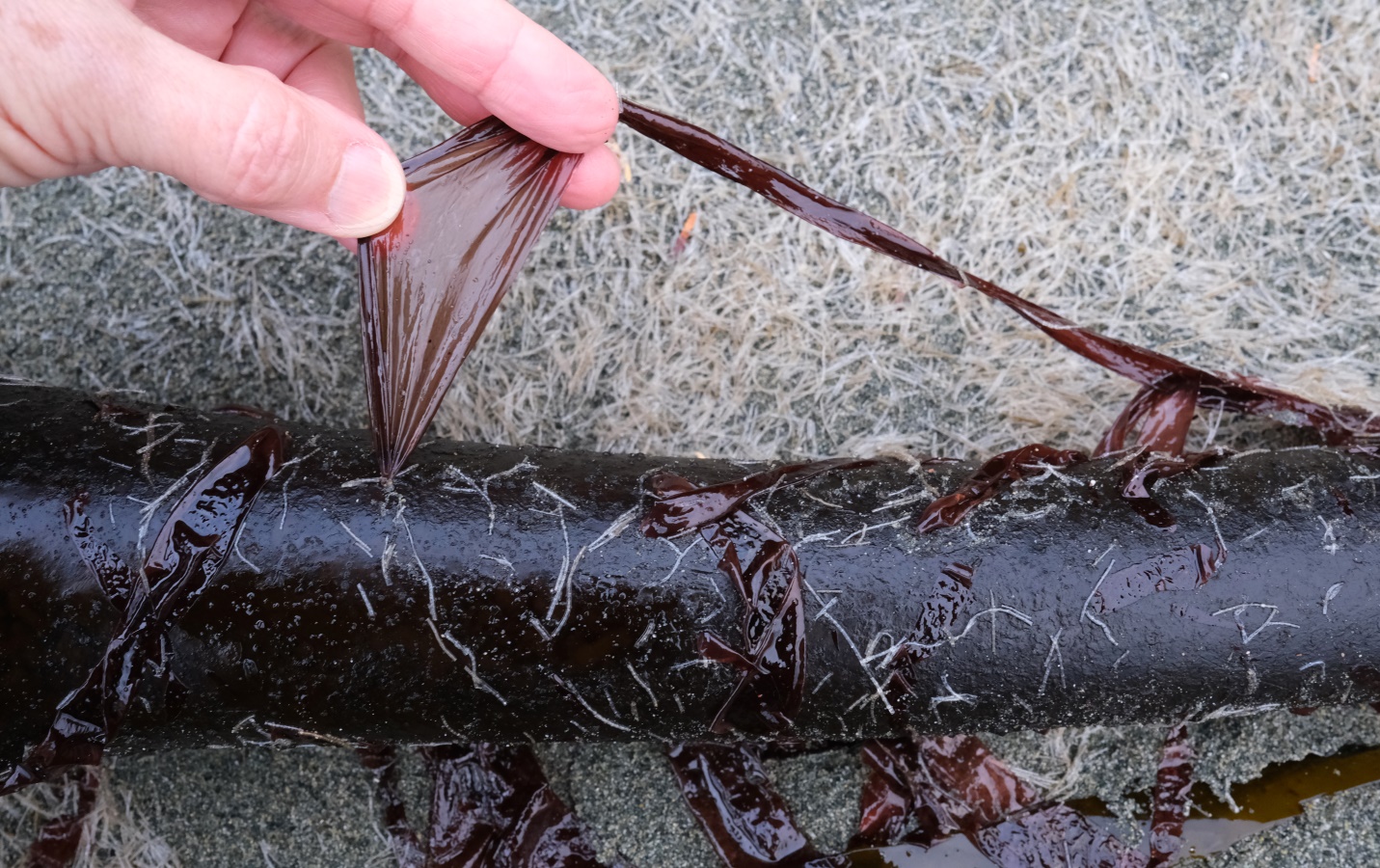
Figure 2: A tug on one blade shows the nori to be both well anchored and elastic. The off-white colored ‘thread- like’ particles that are abundant on the sand behind the Bull kelp stipe and that are also scattered atop the stipe are the casings from the sand dwelling Cellophane Tube Worm, Spiochaetopterus costarum. This organism, like the Bull kelp algae, routinely is seasonally broken off and washed ashore with November/December storms. Florencia Bay, Vancouver Island, B.C. Canada. November 25, 2022. Photo ID 2741 ©Seaweedwhisperings.com
Person 2:
Washed ashore with the recent very high tide and high surf, we found a mature Bull kelp (Nereocystis luetkeana) specimen (complete from holdfast to pneumatocyst and blades) that had been home for numerous strands of Bull Kelp Laver.
The receding tide has left the laver (nori) stretched out here on the sand like so many translucent red crepe ribbons.
All are long and narrow.
Also very thin.
Thin, yes, a simple, single layer built to be nothing more than the minimum manifestation of algae..., because of this Pyropia nereocystis must be able to mingle with the ocean waters so very closely, even intimately.
It is also reaching..., REACHING away in length. Red ribbons that I can picture extending out from and along the length of the Bull kelp stipe.
For what do you reach, Pyropia?
Light?
Love?
Both...?
I tugged at your attachment point on the kelp and found that you hold on well, Pyropia nereocystis. And there is also some stretch to you, you give a bit. Elasticity is one of your traits.
When I tried to flatten out one blade so it was not rolling up or layering over itself I had to really work at this. While the thickness is indeed minimal for this seaweed, it seems like often this same thinness might be doubled up or multilayered. This may give added strength? Less transparency?
Can it be a problem having no mid rib or structure whatsoever? Simply being a flat ‘sheet’ means the sheet may billow and fold and slide over itself at the whim of some other, more powerful influence.
Conversely, I wonder how may it be a benefit to have no such structure...?
One thing noted after walking many kilometers of beach and observing multiple Bull kelp seaweeds that had just recently washed ashore, is that Pyropia nereocystis is NOT present on all of them. Some Bull kelps host a few Bull Kelp Laver algae and some have much of it, and others still have none of the laver at all.
Person 2, second immersion:
Relationships..., it seems that for this seaweed at least one relationship MUST be successful, and that is the one between the nori and the host seaweed. This one relationship Pyropia nereocystis has truly mastered, but what about other ones...?
Is Bull Kelp Laver averse other relationships?
Would they interfere or harm or complicate life too much?
Is this what the long and slender strips of lovely red algae are reaching for? Some kind of relationship with ‘others’ that will not jeopardize their home base, their primary essential relationship? Do they want the ability to easily slide away when a relationship is no longer suitable, when conditions ultimately and inevitably change?
With its ultra-thin morphology is Pyropia nereocystis attempting to bridge the gap between algae and pure sunlight and pure ocean water? Is it parsed down to the sleekest expression so it can “move” as if it is the water, “beam” as if it is the light? So it can be as close as possible to being “at one” with these elements?
Is this the connection, the bond, the relationship that is already a natural part of their life and also one that for Pyropia all other relationships are measured against? If that is the case, it would seem that disappointments would commonly arise – this is a type of almost elemental association that would be very hard to match.
The photos of this seaweed as it lay washed ashore can hint at this “underwater yet near the light” life of Bull Kelp Laver but it is a faint representation. For Pyropia nereocystis, underwater is its place of joy.
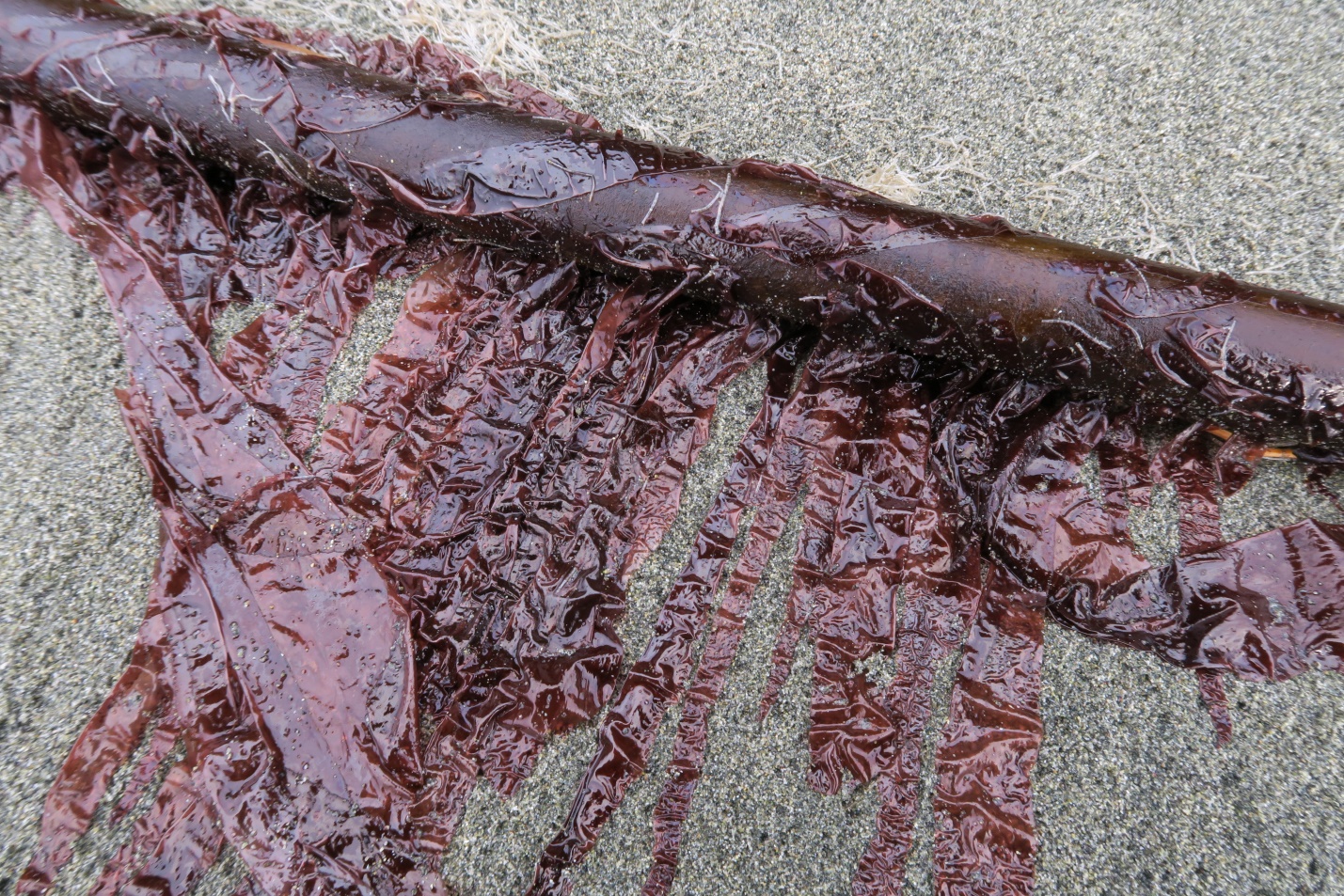
Figure 3: Crinkled “distress” is how we came to understand the look of this laver when it is stranded out of water. Florencia Bay, Vancouver Island, B.C. Canada. November 25, 2022. Photo ID 27442 ©Seaweedwhisperings.com
Discussion:
Long, slender, thin. Long reach. The main dimension that this nori can explore is out, away, growing in length. They have the ability to ‘reach’ in this manner. This dimension is not constrained by its host, or the movement of the host. Pyropia nereocystis can take advantage of what the host offers and it can go beyond those offerings.
What the Bull kelp offers is buoyancy and proximity to sunlight. And, Bull kelp is a very fast growing seaweed, so it also offers increasing ‘habitat’ for the laver to colonize.
Bull kelp does, however, only offer a seasonal opportunity; and this laver’s life cycle is in accord with that seasonality.
Observed out of its habitat, this seaweed seems to almost always crinkle up; the thin sheets do not lie flat. Therefore “crinkle” is a type of distress – a mark of separation from water and of their vulnerability.
Yet these crinkles are also attractive; is this a way they can attract help or attention?
If Pyropia senses their own vulnerability they crumple, they have no other physical posture possible. Is it coincidental that the crumpling and crinkling could also be a protection? Certainly it would slow desiccation.
This laver is very thin, so thin at times it can be a bit TOO close to invisible. With this ‘invisibility’ there arises the need or desire for outside validation or confirmation. Pyropia enjoys approval from others; this is what reinforces their confidence.
The confidence they embody is new, fresh, and they can still easily be in in doubt of their own accomplishments. Affirmation from others is almost critical to help build self-esteem.
Transparency – what can show through sometimes too easily is their freshness and newness. This newness initially shows as vibrancy, but it can also expose vulnerabilities – again, their abilities are recently developed and this often can be plainly seen. Bull Kelp Nori doesn’t want to be “seen through”, though; they often wish to be seen as more experienced and accomplished than they truly are.
Independent movement, or not...? It’s clear that the Bull kelp host itself has a drive to reach and float at the ocean’s surface, to grow its stipe many meters long in order to keep its photosynthesizing blades closest to sunlight. Pyropia nereocystis, however, has no stipe, no floatation mechanism, no mid rib, no branches, it has nothing to hold its shape firmly in place..., it seems these thin, long sheets of algae therefore seek to waft and wave immersed in the sea. And their host gives them suitable proximity to light.
The kelp gives them support, a strong start. This gives a structure that can be relied upon. Pyropia then can reach out further with its own efforts and ambitions. However, the support matters; they cannot reach too far away.
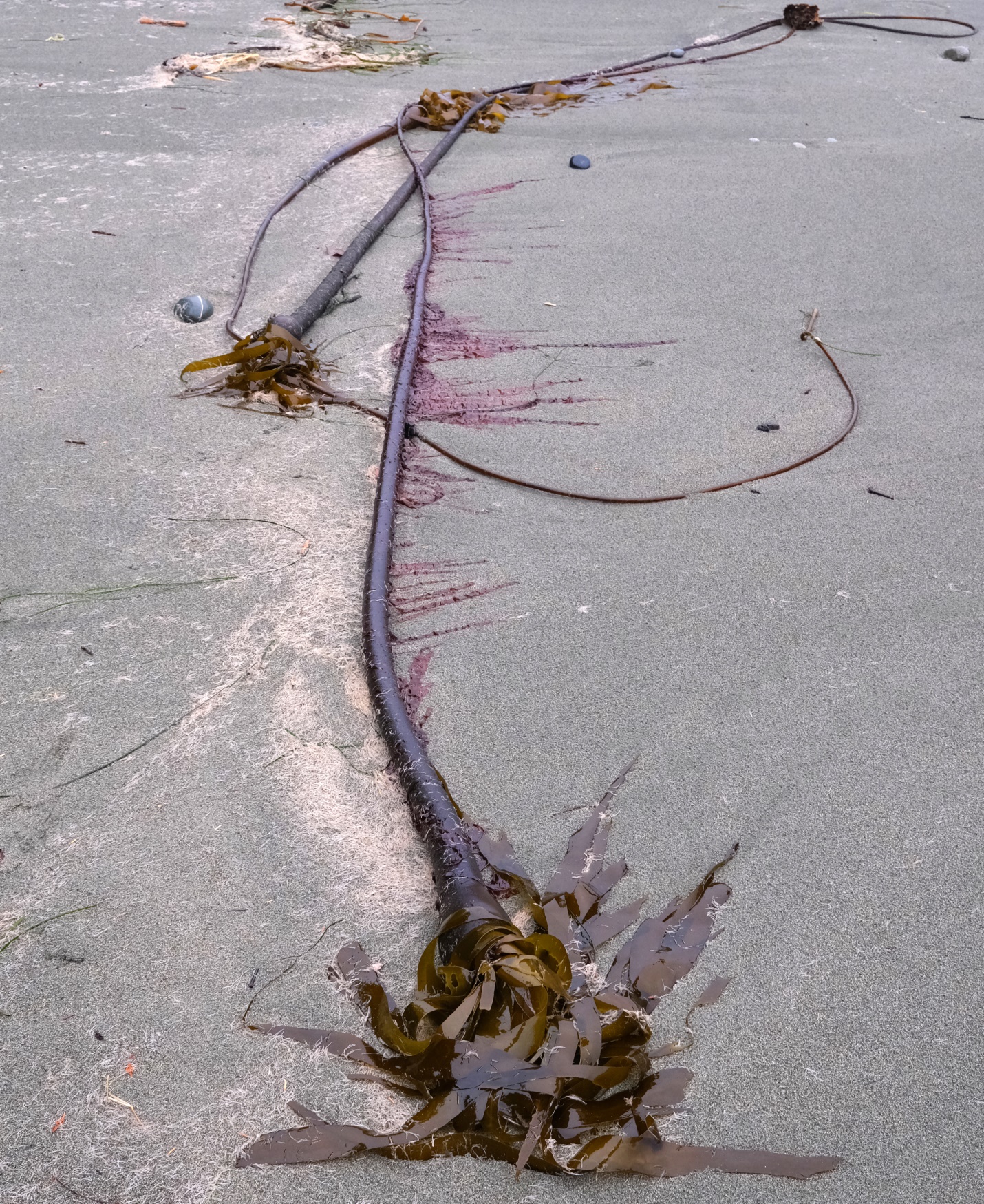
Figure 4: This photo depicts the entire Bull kelp host that we observed; a second Bull kelp is also in the picture and it is devoid of any Pyropia nereocystis. It was clear after walking many kilometers along this beach that not all Bull kelp individuals host this nori, and also no other individual Bull kelp that we found this day had nearly so much nori nor growing so extensively all along the stipe. Florencia Bay, Vancouver Island, B.C. Canada. November 25, 2022. Photo ID 27443 ©Seaweedwhisperings.com
Biology & Natural History Information:
Description:
This species of laver grows in the form of a strap-shaped blade that is very thin, only one cell layer thick. It is found almost exclusively on the stipes of older Bull kelp (Nereocystis luetkeana). Although the dimension of thickness is the smallest possible (only one cell), it can grow up to 3 meters in length and the largest individuals may then measure also up to 30 cm wide. Blades are light red to purple-red, un-branched and much longer than they are wide.
Habitat:
This species grows epiphytically on Bull kelp and only very rarely on other species of kelp. It is always submerged and is therefore is most commonly ‘observed’, out of habitat, in late November when winter storms dislodge and wash ashore the mature Bull kelp.
North Pacific Distribution:
Bull Kelp Laver’s range extends from the eastern Aleutian Islands, Alaska, along the coastlines of British Columbia, Washington and Oregon to central California.
Remarks:
Porphyra cuneformis sometimes grows epiphytically on Bull kelp, but it is two cell layers thick, and is more ruffled and pale in color at the blade margins that Pyropia nereocystis.
Classification:
Phylum: Rhodophyta
Class: Bangiophyceae
Order: Bangiales
Family: Bangiaceae
Genus: Pyropia
Species: Pyropia nereocystis (C.L.Anderson) S.C.Lindstrom 2011
Former name(s):
Porphyra nereocystis C.L.Anderson 1892, Pyropia californica J.Agardh 1899.
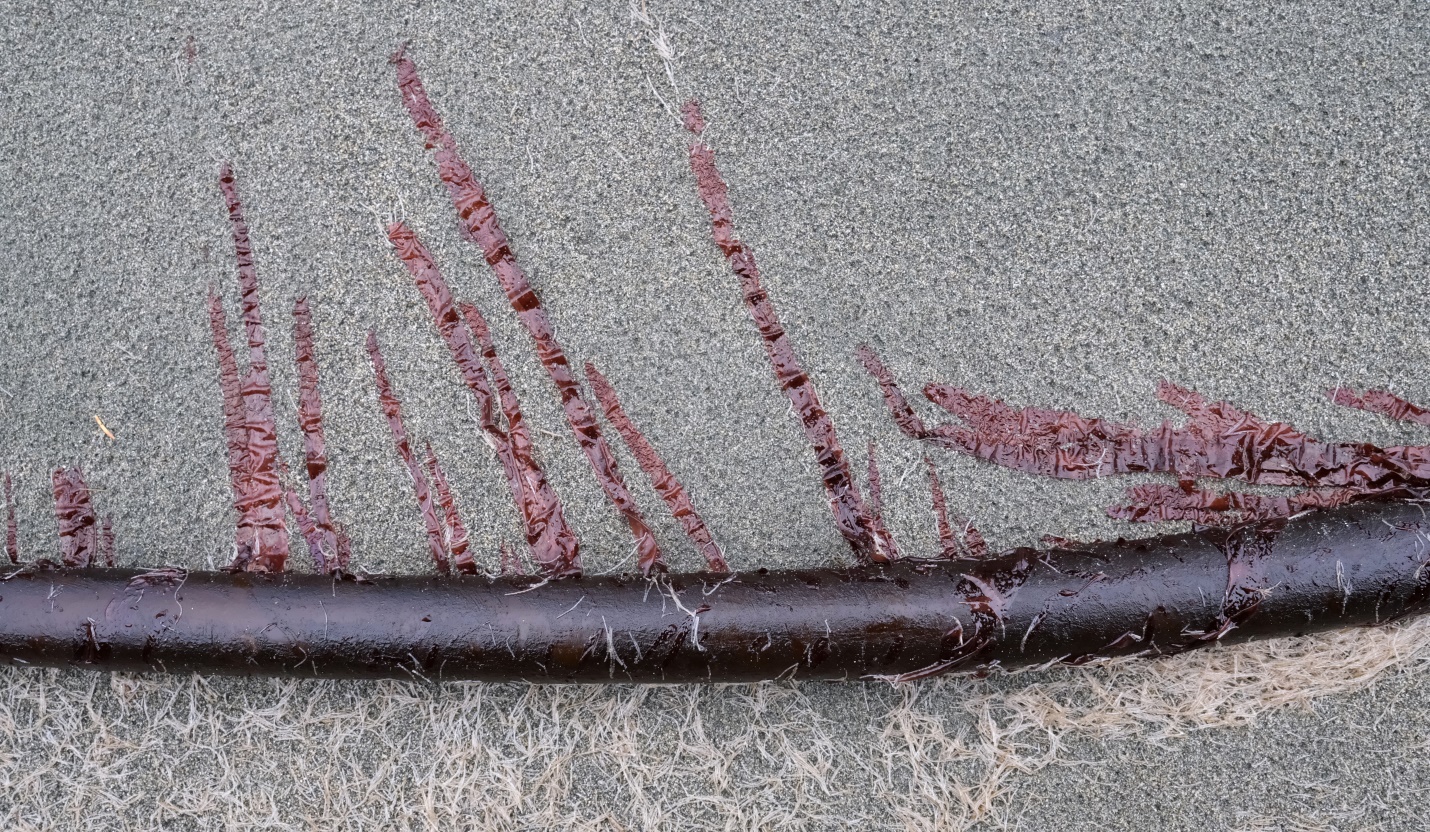
Figure 5: Hopefully this photo depicts the “REACH” that is so evident with this seaweed – it is, indeed, the main expression of growth for Pyropia nereocystis. Florencia Bay, Vancouver Island, B.C. Canada. November 25, 2022. Photo ID 27444 ©Seaweedwhisperings.com
![]()